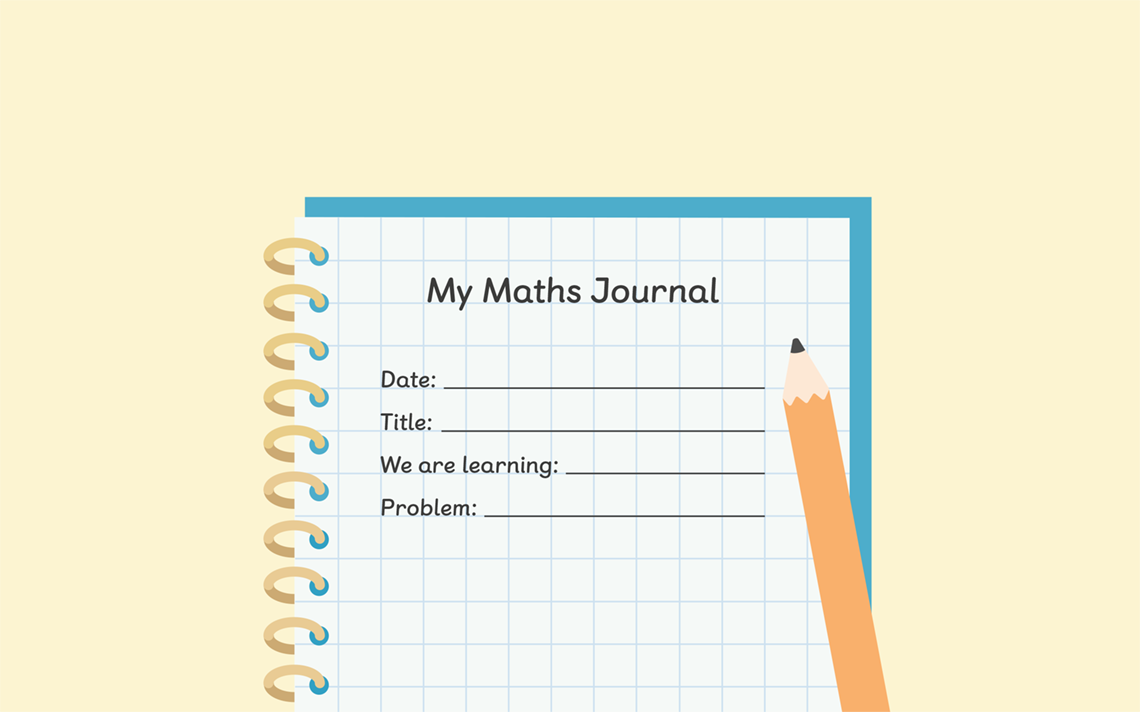What is a maths journal? And other journalling basics
Maths journals give children the opportunity to reflect on their learning and consolidate their understanding. But what is a maths journal? And what does a good maths journal look like?
Maths curriculums all over the world often emphasise the importance of developing learners mathematical fluency, conceptual understanding and reasoning skills. These skills are not always easy to assess. Cue the humble maths journal.
Maths journals are an important part of a maths mastery approach to teaching. For those new to maths mastery, you might be wondering, what is a maths journal?
Let’s lay out the basics.
What is a maths journal?
Maths journals are an exercise book — grid, lined or plain paper — used by learners to record their methods, explanations and ideas for solving maths problems and learning of mathematical concepts.
Maths journals provide teachers with insight into a learner’s thinking and understanding of mathematical ideas, allowing them to assess and address misconceptions as they surface.
What goes at the top of the journal page?
Add the date and title
Every journal entry needs to begin with the date and a title.
Add a learning intention
Often in maths, we begin the lesson by letting children know what mathematical concept they are going to learn that day. We give them the learning intention or the ‘We Are Learning to’ (WALT) to record at the top of their page.
A journal title is similar to a WALT but instead of telling learners the mathematical concept, the journal title comes from the learner and will reflect what they think they have been learning during the lesson.
Set expectations
However, we can’t expect learners to just know how to write a journal title. We do need to model and make them aware of what we expect. A good journal title should reflect the mathematical idea the lesson has focused on. Journal titles offer insight into a learners level of understanding of the concept.
Maths journal title examples
Take the following maths journal title examples from Maths — No Problem! NZ Textbook 2A, Chapter 7, Lesson 6 (the Explore task).
If a child’s journal title for this question is:
- “Subtract from 10”: This might suggest the child has understood the mathematical concept and they are able to use formal mathematical language.
- “Taking away logs”: This might suggest the child has understood the mathematical concept but they are using informal mathematical language.
- “Amira and her logs”: This might suggest the child is not making the link between the mathematical idea and the context of the problem.
Transform Your Maths Assessment
Insights — our online assessment tool — gives you instant, powerful data to identify gaps and improve results.

How many problems should you give your learners?
Journalling follows the structure of George Polya’s research:
“It is better to solve one problem five different ways than to solve five different problems the same way.”
– George Polya
Learners are typically given one problem or mathematical idea to journal about.
Don’t put too much focus on whether your learners solve the problem. Let journals show you how your learners express their mathematical thinking. Encourage your class to use different types of journals to show their understanding of mathematical ideas.
How should you use maths journals at the beginning of a topic?
Journals can be used almost as a diagnostic tool for both learners and teachers. When journalling at the beginning of the chapter, learners may record what they already know about a topic, giving an indication of their starting point.
How should you use maths journals throughout the chapter?
Learners may journal a number of times throughout a unit of work. These journals may reflect different methods, representations or discoveries they have made to explain their understanding of concepts.
How should you use maths journals at the end of a topic?
Journalling can be used at the end of a topic as an assessment tool — recording what the children have learned. It can often be interesting for learners and teachers to compare journals at the beginning of the unit with journals at the end of the unit.
How to scaffold with maths journal prompts
Prompt learners to include diagrams, numbers and words
Learners should be encouraged to articulate and explain their thinking using written explanations, diagrams and numerical representations in their journals.
Here’s an interesting maths journal prompt. As mathematical ideas become more complex, words will not always be the most effective way to articulate information, journalling can provide an opportunity for learners to develop the ability to present information verbally, numerically and visually.
Prompt the use of mathematical language
Mathematical language is an important part of being able to understand the abstract symbols we use in maths to represent ideas. Journalling provides learners with an opportunity to explain their understanding of concepts using mathematical vocabulary, taking learning deeper. Why not keep this maths journal prompt in mind for your next lesson?
How often should learners journal?
The more learners journal, the more beneficial it will be for them. Daily journalling develops children’s metacognition skills. It encourages them to reflect on the mathematical concepts being learned and how to best articulate their thinking.
If you’re new to the mastery approach, journalling is a practice that can increase in frequency as learners become more familiar with the learning style. Mastery style lessons are often far more robust than how learners may have previously been taught, if they have come from an ability group setting.
Many teachers find it difficult to fit journalling into every lesson at first, so they will gradually increase the frequency of journalling as everyone becomes more confident and familiar with the lesson content and structure.
Maths journalling can be unstructured and there is really no ‘right way’ to do it. But following these journalling fundamentals will ensure learners develop a deeper understanding of mathematical concepts.

